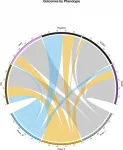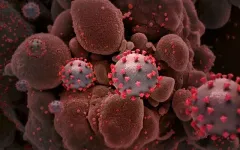(Press-News.org) Wearing a face mask can protect yourself and others from Covid-19, but the type of material and how many fabric layers used can significantly affect exposure risk, finds a study from the Georgia Institute of Technology.
The study measured the filtration efficiency of submicron particles passing through a variety of different materials. For comparison, a human hair is about 50 microns in diameter while 1 millimeter is 1,000 microns in size.
"A submicron particle can stay in the air for hours and days, depending on the ventilation, so if you have a room that is not ventilated or poorly ventilated then these small particles can stay there for a very long period of time," said Nga Lee (Sally) Ng, associate professor and Tanner Faculty Fellow in the School of Chemical and Biomolecular Engineering and the School of Earth and Atmospheric Sciences.
The study was conducted during spring 2020, when the pandemic triggered a global shutdown of most institutions. Communities faced massive shortages of personal protective equipment, prompting many people to make their own homemade masks. Georgia Tech quickly set up the study since it already had "a great system for testing filtration efficiency using existing instruments in the lab," Ng recalled.
The study's findings were used to shape homemade face mask recommendations here last April, with the comprehensive study findings published on March 22 in the journal Aerosol Science and Technology.
In all, the researchers tested 33 different commercially accessible materials not limited to cloth fabrics, including single-layer woven fabrics such as cotton and woven polyester, blended fabrics, nonwoven materials, cellulose-based materials, materials commonly found and used in hospitals, and various filter materials.
"We learned there was a lot of variability in filtration performance even in the same type of material," Ng said.
"We found commercially available materials that provide acceptable levels of submicron particle rejection while still maintaining air flow resistance similar to a surgical mask," said Ryan Lively, an associate professor and John H. Woody Faculty Fellow in the School of Chemical and Biomolecular Engineering. "These materials combine fabric fiber density, a maze-like structure, and fiber surface chemistry to effectively reject submicron particles."
The best-performing materials for homemade masks were blackout drapery and sterilization wrap widely used for packing surgical instruments. Both materials are commercially available.
The researchers said people should avoid using filters such as a HEPA/MERV or vacuum bags unless they are certified to be fiberglass-free since often such filters on their own may release glass fibers that can be inhaled. Other materials to avoid for masks include loose-knitted material, batting fabric, felt, fleece, or shiny, reusable shopping bags.
Multilayered samples performed much better than single-layer samples, but people should pay attention to breathability. The two-layered and three-layered samples tested show an overall filtration efficiency of about 50% for submicron particles. Mask fit is also important since particles can easily escape through gaps at the nose or through the sides of the mask.
The analysis showed that properly fitted and multilayer masks reject 84% of particles expelled by a person when one person wears it. Two people donning these types of masks reduces particle transmission by 96%.
A final takeaway of the research was the importance of universal mask wearing.
"The best way to protect ourselves and others is to reduce exhaled particles at the source, and the source is our face," Ng said, adding, "That really gets amplified when everyone starts wearing masks."
She expressed optimism that the findings will motivate people to more widely embrace mask wearing if they are sick and need to be in public.
"Not everyone understands the importance of airborne virus transmission, and the importance of wearing a mask," she said. "I hope that the practice will continue to help reduce the release of these viral particles into the environment and help protect others."
INFORMATION:
In addition to Ng and Lively, the researchers included Taekyu Joo, Masayuki Takeuchi, Fobang Liu, Matthew P. Rivera, and Bahnisikha Dutta from Georgia Tech; Joy Barr and Eric Parker from theClubhou.se; Emily S. Blum and John H. Tipton from the Global Center for Medical Innovation; and Julia Varnedoef from Cobb County (Georgia) Schools.
Additional Media Relations Contact
Tracey A. Reeves (tracey.reeves@gatech.edu)
The Georgia Institute of Technology, or Georgia Tech, is a top 10 public research university developing leaders who advance technology and improve the human condition.
The Institute offers business, computing, design, engineering, liberal arts, and sciences degrees. Its nearly 40,000 students, representing 50 states and 149 countries, study at the main campus in Atlanta, at campuses in France and China, and through distance and online learning.
As a leading technological university, Georgia Tech is an engine of economic development for Georgia, the Southeast, and the nation, conducting more than $1 billion in research annually for government, industry, and society.
New research led by investigators from Boston Medical Center and Grady Memorial Hospital demonstrates the significant decline in hospitalizations for neurological emergencies during the COVID-19 pandemic. The rate of Subarachnoid hemorrhage (SAH) - bleeding in the space between the brain and the tissue covering the brain - hospitalizations declined 22.5 percent during the study period, which is consistent with the other reported decreases in emergencies such as stroke or heart attacks.
Published in Stroke & Vascular Neurology, the study compares subarachnoid hemorrhage hospital admissions for the months following throughout the initial COVID surge, in hospitals that bore ...
In a new study, researchers identify three clinical COVID-19 phenotypes, reflecting patient populations with different comorbidities, complications and clinical outcomes. The three phenotypes are described in a paper published this week in the open-access journal PLOS ONE 1st authors Elizabeth Lusczek and Nicholas Ingraham of University of Minnesota Medical School, US, and colleagues.
COVID-19 has infected more than 18 million people and led to more than 700,000 deaths around the world. Emergency department presentation varies widely, suggesting that distinct clinical phenotypes exist and, importantly, that these distinct phenotypic presentations may respond differently ...
HOUSTON - (April 2, 2021) - Understanding what drives food choices can help high-volume food service operations like universities reduce waste, according to a new study.
Researchers have concluded that food waste in places like university cafeterias is driven by how much people put on their plates, how familiar they are with what's on the menu and how much they like - or don't like - what they're served.
Food waste has been studied often in households, but not so often in institutional settings like university dining commons. What drives food choices in these "all-you-care-to-eat" facilities is different because diners don't perceive personal financial penalty if they leave food on their plates.
Published in the journal Foods, "Food Choice and Waste in University Dining Commons ...
A personalized tumor cell vaccine strategy targeting Myc oncogenes combined with checkpoint therapy creates an effective immune response that bypasses antigen selection and immune privilege, according to a pre-clinical study for neuroblastoma and melanoma. The neuroblastoma model showed a 75% cure with long-term survival, researchers at Children's National Hospital found.
Myc is a family of regulator genes and proto-oncogenes that help manage cell growth and differentiation in the body. When Myc mutates to an oncogene, it can promote cancer cell growth. The Myc oncogenes are ...
James McKerrow, MD, PhD, dean of the Skaggs School of Pharmacy and Pharmaceutical Sciences at University of California San Diego, has long studied neglected tropical diseases -- chronic and disabling parasitic infections that primarily affect poor and underserved communities in developing nations. They're called "neglected" because there is little financial incentive for pharmaceutical companies to develop therapies for them.
One of these neglected diseases is Chagas disease, the leading cause of heart failure in Latin America, which is spread by "kissing bugs" carrying the parasite Trypanosoma cruzi. These parasites produce an enzyme called cruzain that helps ...
A novel mechanism has been identified that might explain why a rare mutation is associated with familial Alzheimer's disease in a new study by investigators at the University of Chicago. The paper, published on April 2 in the Journal of Experimental Medicine, characterizes a mutation located in a genetic region that was not previously thought be pathogenic, upending assumptions about what kinds of mutations can be associated with Alzheimer's Disease.
Alzheimer's, a neurodegenerative disease that currently affects more than 6 million Americans, has ...
Buck Institute researchers have discovered and are developing a novel, non-invasive biomarker test that can be used to measure and track performance of senolytics: a class of drugs that selectively eliminate senescent cells. The discovery is expected to play a major role in efforts to develop treatments that would battle a myriad of chronic age-related conditions that range from arthritis to lung disease to Alzheimer's disease and glaucoma. This biomarker is a unique signaling lipid metabolite, normally exclusively intracellular, but is released when senescent cells are forced to die. This metabolite is detectible in blood and urine, making non-invasive ...
Gasoline, the primary transportation fuel, contains hydrocarbons with 5-11 carbons (C5-11) and is almost derived from petroleum at present.
Gasoline can also be produced from non-petroleum syngas. Nonetheless, achieving high conversions of syngas to C5-11 with excellent selectivity and stability remains a challenge.
A research group led by Prof. LIU Zhongmin and Prof. ZHU Wenliang from the Dalian Institute of Chemical Physics (DICP) of the Chinese Academy of Sciences realized highly efficient and selective conversion of syngas to gasoline-range liquid hydrocarbons over a dual-bed catalyst.
The study was published in Chem Catalysis on April 2.
This dual-bed catalyst, (CZA +Al2O3)/N-ZSM-5(97), consists ...
Up to one in five employees at an academic medical institution are considering leaving their professions due to the strains of coping with the pandemic in their own lives, according to a new University of Utah Health study. Individuals who had caregiving responsibilities were among those most likely to contemplate leaving or reducing hours.
The findings suggest that retaining highly trained doctors, nurses, and scientists in the aftermath of the COVID-19 pandemic could be the next great health care challenge.
"It's sobering to learn that, during a time of economic recession, at least one-fifth of our workforce were considering leaving their jobs because of the severe levels of stress they were experiencing," says Angela Fagerlin, Ph.D., the study's senior author and professor ...
SAN FRANCISCO, CA (April 2, 2021) -- In recent years, advancements in DNA sequencing have exposed a large amount of hidden diversity in reef-building corals: species that appear identical to one another but are genetically distinct. Typically ignored as they are invisible to the naked eye, a team of researchers at the California Academy of Sciences and The University of Queensland, along with over a dozen international collaborators, is taking a more holistic approach to understand these hidden species by investigating overlooked ecological differences that have wide-ranging implications for the vulnerability and resilience of reef-building corals. The team hopes that their findings, ...





